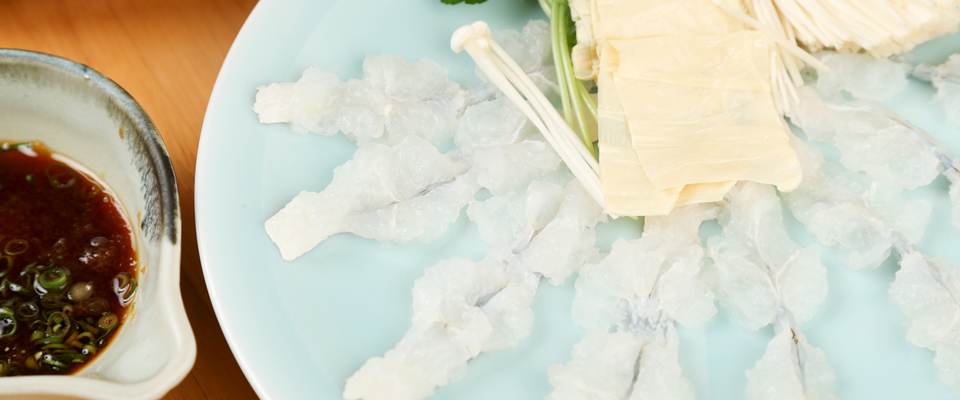Greeting
Welcome to our restaurant, Fuku-shin. We have been a Fugu & Hamo specialty restaurant
since we started in 1959. Our policy has been we offer food & drinks which we judge only
the finest. And thanks to being patronized by so many guests,
we have been here untiltoday.
The name of us is Fuku-shin, not Fugu-shin. The reason why we don’t avoid the voiced
consonant is, because we follow the way that inhabitants/fishermen, who live in
Shimonoseki, the westernmost city of Honshu Island, pronounce. Fugu fishes we serve here
are from Shimonoseki, therefore we follow them to do so.
People in Shimonoseki call it FUKU. Why people in Shimonoseki avoid calling the fish
FUGU is its sound is inauspicious. Because one of the homophone word, FUGŪ(不遇)
means “misfortune” in Japanese language! On the contrary, a word without voiced
consonant FUKU(福) means “happiness” and people in Shimonoseki take that way.
Very fresh (in Japanese language, fresh = shin) fishes are only offered here and we are the
specialist of not Fugu but Fuku. So the name has come from these meanings.
Anyway, we would like you to have a good time here with us. Enjoy!
Fugu course meal
Choose from 3 courses of A, B or C.
Starter, Tessa (Fugu sashimi), rice porridge and dessert are all served and
they are completely the same amount and quality at any course you choose.
The difference between the course A, B and C is the
number of pieces of Fugumeat served.

Course A
¥14,960- pp(Tax inc.)
- Strater
- Tessa (Fugu sashimi)
- 10 pieces of Fugu meat*
- Rice porridge
- Dessert
*Fugu meat can be cooked as you like,
charcoal-grilled, fried or boiled. And
you can also choose more than 2 cooking ways,
such as 3 grilled, 3 fried and4 boiled.

Course B
¥11,000- pp(Tax inc.)
→Select from Course B-1, B-2 or B-3.
- Course B-1 (Charcoal-grilled Course): Starter, Tessa (Fugu sashimi),
5 pieces of Charcoal-grilled Fugu meat, Rice porridge & Dessert. - Course B-2 (Fried Course): Starter, Tessa (Fugu sashimi),
5 pieces of Fried Fugu meat, Rice porridge & Dessert. - Course B-3 (Boiled Course): Starter, Tessa (Fugu sashimi),
5 pieces of Boiled Fugu meat, Rice porridge & Dessert.

Course C
¥13,200- pp(Tax inc.)
- Strater
- Tessa (Fugu sashimi)
- 7 pieces of Fugu meat* →How to be cooked, select from (1) or (2). (1) 3 pieces of Charcoal-grilled & 4 pieces of Boiled. (2) 3 pieces of Fried & 4 pieces of Boiled.
- Rice porridge
- Dessert
Hamo course meal
(Reservation is required by the previous day)
Choose from 2 courses of “Regular” or “Small”.
The difference is only quantity. “Small” is
two thirds of “Regular”. Contents are completely the same

- Hamo “Regular” Course Meal ¥8,250- pp (Tax inc.)
- Hamo “Small” Course Meal¥5,500- pp (Tax inc.)
- Starter (Hamo Chu-ru-rin)
- Boiled Hamo meat on gelatin noodles served with soup of mixing ponzu (a seasoning made from citrus juice) with dashi (soup stock made from bonito & kelp).
- Hamo Otoshi
- Hamo meat (boiled, then soaked in iced water) served with plum sauce.
Hamo Shimo-Zukuri - Hamo sashimi with its skin (skin only seared very lightly, meat remains raw) Hamo Kushi Sumi-bi Yaki
- Charcoal-grilled Hamo meat on a forked skewer served with condiment paste made from green pepper & yuzu (citrus junos) zest.
- Hamo Tempura
- Contains deep-fried Hamo meat, sweet pepper & soft yuba (beancurd skin) and served with special tempura sauce & salt.
- Hamo Shabu-shabu
- Contains raw Hamo meat, soft yuba (beancurd skin), Japanese honeywort & winter mushroom and served with ponzu, grated radish & chopped leek.
- The way of eating is, first, raw Hamo meat is picked by chopsticks and soaked into the pot, then keep holding it and swing it twice or three times. When the meat becomes like a flower, it is time to pull up and dip in ponzu, grated radish & chopped leek and have it.
- Rice porridge
- After completing Shabu-shabu, rice is added to the Shabu-shabu pot and rice porridge is cooked with egg, chopped leek and laver. It is seasoned with salt & light soy source.
- Dessert
- Seasonal fruit
á la carte/Beverages
-
á la carte
- Yu-biki (Teppi, boiled & Sliced Fugu’s skin)
-
Small¥1,100-
Medium¥2,200-
Large¥3,300- - Tessa (Fugu’s sashimi)
- ¥6,050-
- Sumi-bi Shio-yaki (6 pieces of charcoal-grilled Fugu)
- ¥6,600-
- Kara-age (6 pieces of fried Fugu)
- ¥6,600-
- Tecchiri (6 piece of boiled Fugu)
- ¥6,050-
- Option: Zosui (Rice porridge cooked in the Tecchiri pot)
- ¥990-
- Zosui (Rice porridge with Chinese cabbage & mushroom)
- ¥1,870-
-
Beverages
- Hire-sake (hot sake with grilled Fugu fins) -The fins of the fish are dried out completely, baked, and served in hot sake
- ¥880-
- Sake [Ozeki] Served Heated or room temperature
- ¥770-
- Cold Sake [Ozeki Daiginjo]
- ¥1,100-
- Beer
-
Asahi¥730-
Kirin¥730-
Ebisu¥730- - Shochu (Distilled spirits)
Select from Mugi (Barley) or Imo (Sweet potato) -
Served with water/hot water¥450-
Served with ice ¥550- - Umeshu (Plum wine, served with ice)
- ¥550-
- Oolong Tea
- ¥220-
About Fugu
Fugu (Pufferfish/Globefish/blowfish) is a whitefish and famous for a prized and healthy food. It contains high-protein, low-fat and rich in collagen. However,
Fugu, such good food, has poison (tetrodotoxin) like no rose without a thorn.
To handle Fugu’s poison is not easy because depending on the type of Fugu,
site of poison is different.
Which parts are poisonous in Fugu? See the example below.
| Deadly poisonous (very strong) 猛毒 |
Virulent (strong) 強毒 |
Attenuate (weak) 弱毒 |
Edible 可食 |
|
|---|---|---|---|---|
| Tiger puffer (Tora-fugu) とらふぐ |
Liver 肝臓 | Ovary 卵巣 | Stomach 胃 Intestines 腸 Kidney 腎臓 Heart 心臓 Spleen 脾臓 Gallbladder 胆嚢 Gills えら Eyes 目 |
Meat 身 Fins ひれ Operculum かま Bill/Beak くちばし Milt 精巣(白子) Skin 皮 |
| Purple puffer (Ma-fugu) まふぐ |
Liver 肝臓 Ovary 卵巣 |
Intestines 腸 Skin 皮 |
Stomach 胃 Kidney 腎臓 Heart 心臓 Spleen 脾臓 Gallbladder 胆嚢 Gills えら Eyes 目 |
Meat 身 Fins ひれ Operculum かま Bill/Beak くちばし Milt 精巣(白子) |
| Bluebacked puffer (Goma-fugu) ごまふぐ |
Liver 肝臓 | Ovary 卵巣 | Stomach 胃 Intestines 腸 Kidney 腎臓 Heart 心臓 Spleen 脾臓 Gallbladder 胆嚢 Gills えら Skin 皮 Eyes 目 |
Meat 身 Fins ひれ Operculum かま Bill/Beak くちばし Milt 精巣(白子) |

Therefore the chefs have to have “the Fugu Preparation license”. The licensees are able to perfectly classify the type of Fugu, identify poisonous parts and non-poisonous parts, remove poisonous parts completely and prepare in the right way. This is why Fugu meals served by the licensees are edible and safe.
So please relax and try Fugu meals here as we have been the licensee for over 50 years! We are certain to serve our guests the 100% safe and delicious Fugucuisine here.
Although many types of Fugu are caught and eaten in Japan, especially, tiger puffer (Tora-fugu) is larger compared to the other, and so delicious that it is called “the King of Fugu”. Its best season is winter. And then purple puffer (Ma-fugu) is called “the Queen of Fugu” which is slightly smaller than tiger puffer and the best season is throughout spring.
We mainly use tiger puffer (September to June) and purple puffer (April to July) for our Fugu menu, and offer to you. We also start using bluebacked puffer,
which is caught a lot in summer and also tastes very good, from summertime in 2017 to serve Fugu for a whole year.
Now you can enjoy Fugu meals here with us any time of the year.
Please enjoy the meal!
About Hamo
We would like you to try Hamo (daggertooth pike conger) in summertime. Hamo is not poisonous at all but edible every part and it is very healthy food.
It contains high-protein,calcium, iron, vitamins and so on.
However, it has so many small bones that they bother us to eat. The bones are cut very finely by the skilled chef with using a special knife. The cutting skill is one of the most difficult cooking skills; our Hamo chefs used to have very tough training and they can make cuts for 24 times in 1 SUN (about 3.03 centimeters) of Hamo meat while never cutting through the skin. The skill makes the meat easier to eat.
Please enjoy Hamo meals!



